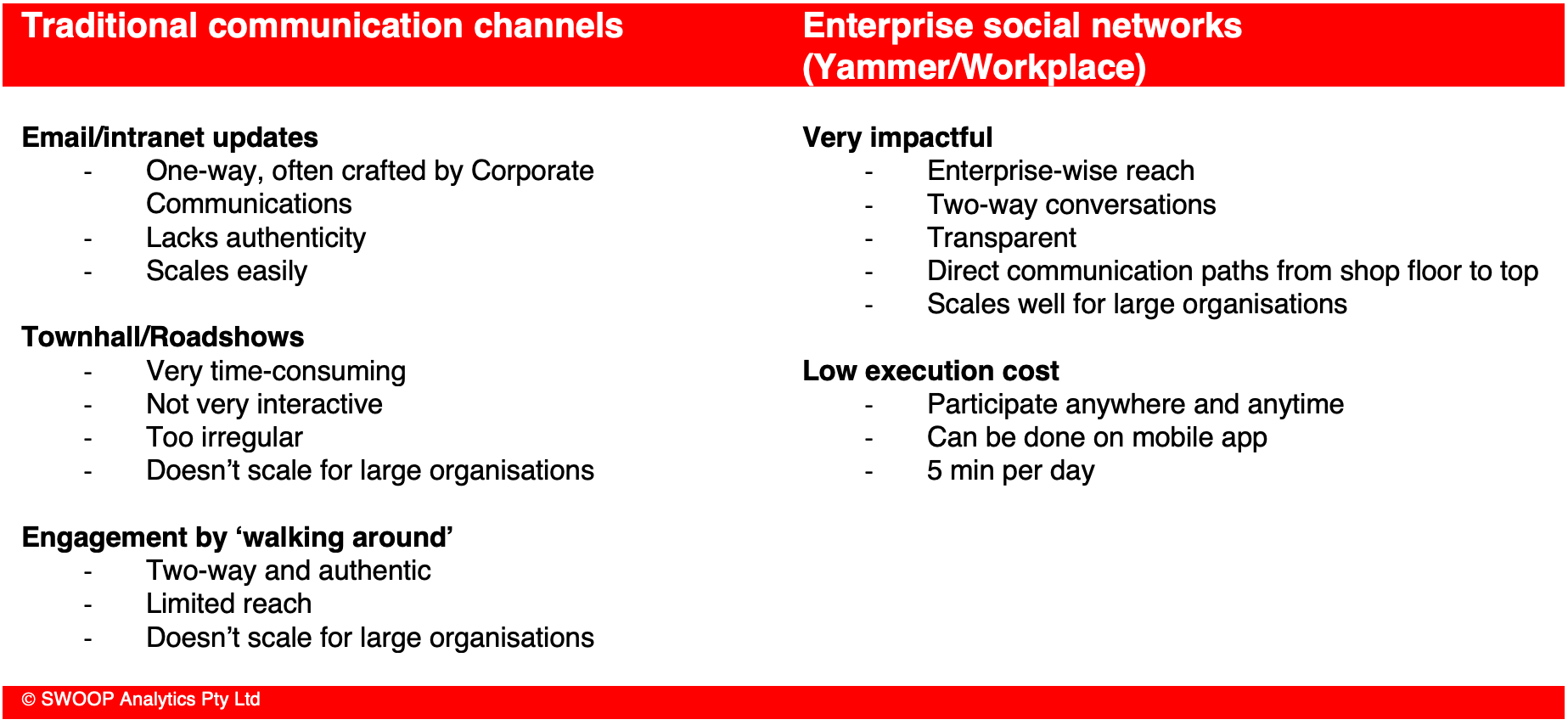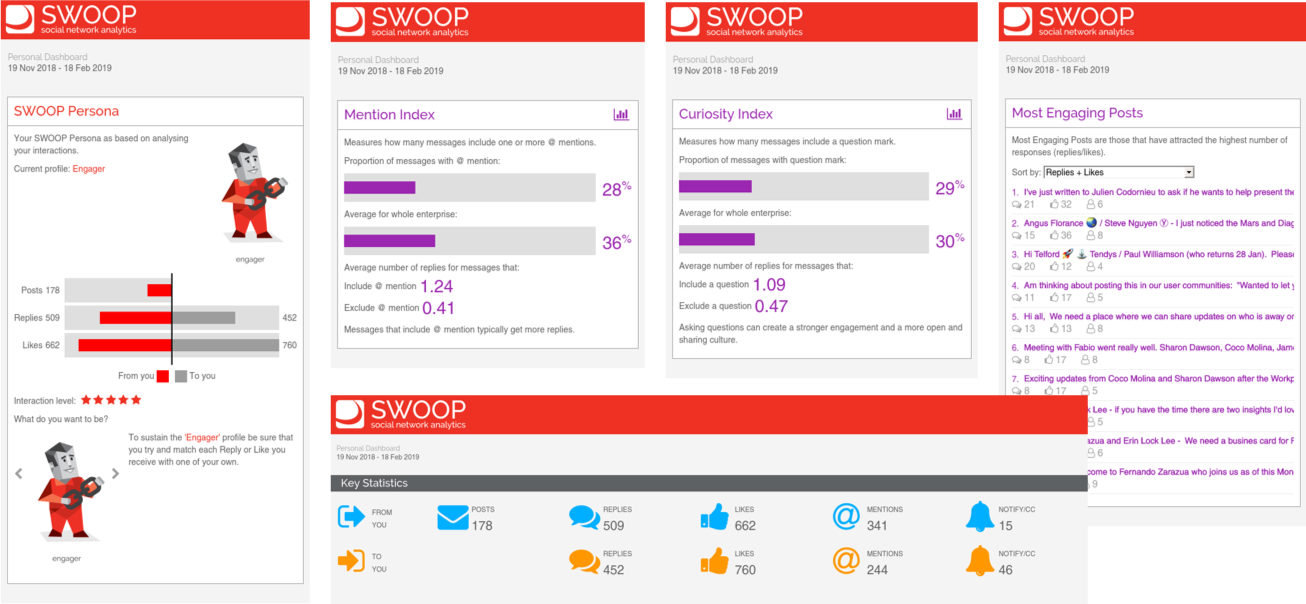Engagement At Scale: What Senior Leaders Need To Do
It is more important than ever for senior leaders to build trust by establishing two-way conversations with their people – at scale. In this article, we’ll give simple, practical and evidence-based tips for achieving this spending just five minutes per day. We’ll also show you how to measure this at the individual level.
Change is constant. Trust in senior leaders is critical for implementing change at speed, and trust comes only through building relationships. The challenge is that most of the existing channels senior leaders access to engage with their people are either not great at two-way engagement (e.g. email updates), or they just don’t scale (e.g. face-to-face meetings).
When you consider how much time senior leaders spend on email updates, phone/video conferences, town-hall meetings, roadshows etc it’s unsatisfying that this doesn’t move the dial on people feeling connected to their leaders.
However, over the last few years new ways of having two-way interactions with people at scale have emerged. Enterprise Social Networks such as Microsoft Yammer and Workplace by Facebook are entering organisations at a rapid pace. As the table below shows, these platforms have substantial benefits over traditional engagement methods.
Senior leaders are already spending a significant amount of time trying to engage their people using traditional channels, but with limited impact. Reducing that effort slightly can free up 5 minutes per day which can then be used in more impactful ways. Therefore, it is no surprise that smart CEOs are using these social tools[1].
As an example, look at this post from ex-CEO of NBN Co Bill Morrow. His post completely turns upside down the traditional approach commonly used by senior leaders:
Rather than telling, Morrow asks his people what they would like to hear. Simple, but very powerful. He demonstrates that he is interested in their perspectives rather than assuming that he knows what they want.
David Rees, CEO of Service NSW, a government agency with almost 100 service centres and more than 2,300 employees, is also tapping into his people to better understand how he and his executive team can better connect with them:
What to do in 5 mins?
Posting updates is powerful, but senior leaders should remember that Yammer/Workplace is primarily serving as a hearing aid rather than megaphone. If you want your people to trust you, you need to show you’re listening. You can show you’re listening by commenting on people’s posts with comments like; “Interesting observation. I hadn’t thought of that.” or you could simply click ‘like’. The act of ‘liking’ a message posted by someone on the shop floor can literally energise that person for a whole week. Not a bad return on a single click. Also, if you ‘like’ someone’s post, SWOOP research shows it is three times more likely they will like yours when you post.
To achieve a reasonable balance between posting, replying and liking we offer this simple 1/2/3 rule:
If you find yourself mostly posting, but rarely replying or liking messages, you are effectively using Yammer/Workplace as a megaphone, and it’s time to change.
In addition to giving senior leaders simple direction for how to balance their interactions, the 1/2/3 rule also sets a realistic benchmark for how much they should do on a weekly basis. Writing a post, a couple of replies and a few likes during the week is very achievable. Having the app on your mobile phone makes it convenient to provide quick updates between meetings or posting a photo when visiting a branch office.
Short, frequent updates build trust over time. It’s not different to how our personal relationships work. You can’t fix a relationship by going away on a romantic long weekend once or twice a year. It requires small acts of kindness all year round.
Most senior leaders may not fully appreciate the authority and respect that automatically flows from the seniority of their roles. People further down the corporate hierarchy are, in most circumstances, not going to put forward comments which they fear could potentially be perceived negatively. If senior leaders want to build trust it is therefore paramount they give permission for their people to engage with them. This can be achieved by asking questions.
Questions should be specific and relevant to a broad audience to elicit the most replies. When you ask the question it also has the added benefit of being able to direct the conversation to an area that senior leaders feel contributes to relevant business objectives. The graphic below includes a few examples of specific questions senior leaders could ask.
SWOOP research has found messages that include a question get 150% more replies. On average, 10% of messages include questions, and senior leaders should exceed this average in an effort to seek more feedback from their people. In SWOOP, seniors can track how many questions they ask, and each person can also see exactly how many replies they get then they ask a question and when they don’t.
Take for example ex-CEO of Telstra (a large telco with 55,000 employees), David Thodey, who wanted to change a corporate culture that was putting process over customer service. He simply asked his people to post their “top time wasting and unnecessary approval or process and we will either fix it or explain why it exists”:
People on the frontline servicing customers knew exactly what was holding them back. All they needed was to feel that their feedback was genuinely sought and – where relevant – would be acted upon. Insiders told SWOOP that 60% cent of all feedback was implemented.
What, where to post, and how much to write?
The problem with contributing is often associated with a fear of “writer’s block”. To get started we offer this simple advice: Don’t worry about posting. Start by ‘liking’. This takes a minimum amount of effort and shows that you are taking an interest. This is exactly the same as nodding during a face-to-face conversation. When you join a group of people who are already talking, the polite approach is to start by listening (i.e. ‘liking’). Once you know what people are talking about, you can contribute to the conversation (i.e. ‘replying’). After that, you can start a conversation about a new topic (i.e. ‘posting’ a new message).
Now that you’re ready to write your first post, how much – or how little – should you write? To determine that, we researched how long the messages are that get the most replies. It turns out that writing too little, or too much, will lead to fewer replies. The sweet spot for new posts is between 500-2000 characters. The two pieces of graphic in the middle of the chart below shows this:
As the Morrow and Thodey examples showed, you can get away with writing less if you are asking for specific feedback.
Another powerful technique involves tagging people that you are particularly interested in doing something with your post. In a face-to-face meeting with a large group of people this is something we do all the time. We call out a name, for instance; “Anna, what do you think about this?”. When applied online, this technique of tagging, also referred to as @ mentioning a person, leads to 73% more replies. In SWOOP, seniors can track how often they @ mention others, and each person can also see exactly how many replies they get then they @ mention and when they don’t.
Let’s cover where senior leaders should post. If the point is to engage people at scale, and have impact across the organisation, then it should be posted in a relevant group which is open for all employees to join. For example, Microsoft CEO Satya Nadella has created a group he has called CEO Connection where he can engage with all Microsoft employees from around the world.
When you first start out, creating a special group for this purpose has several benefits. First, it makes it clear to your people where they will find the senior leaders. For the senior leader it also makes it simpler as there’s only one place to focus.
Another, or parallel, option could be to seek out a non-work related group. Groups for pets, photography or similar are often very popular. While at a first glance a senior leader might disregard this as frivilous, it offers the opportunity for a senior leader to present a more personable aspect of her- or himself, and could make it easier for others to relate to her/him (and therefore trust).
The ideal engagement profile
To help senior leaders quickly gauge how well they are tracking, SWOOP has developed a set of five behavioural personas which are automatically generated based on each person’s individual interaction patterns.
When the goal is to establish trust via authentic and transparent interactions, being an Observer is not desirable. Nor is a Broadcaster. That leaves us with the Respondent, Catalyst and Engager.
We suggest that while the Responder is positive, senior leaders should be more proactive in starting conversations as respect for seniority means that people generally hold back. Therefore, being a Catalyst is a good first goal and is easy to achieve. That is because once senior leaders start asking questions and showing an interest by liking and replying, then a large number of people will reciprocate.
The most aspirational persona, and the most challenging for senior leaders, is the Engager. To be an Engager, the senior leader will need to create a balance between what they do and what they get back. It’s hard to achieve as it requires the senior leader to really think about the conversations they want to start, how it would engage their people, and then ensure they reciprocate replies they get with replies and likes. This is similar to the role of a host at a dinner party who ensures the conversation is relevant for as many people as possible by focusing on topics that have broad appeal, ensuring that everyone gets an opportunity to participate. The social cues of calling out a person’s name, making eye contact, nodding, asking questions, making introductions etc are all elements that can be replicated online as outlined above. Those are the skills an Engager masters.
Measuring with SWOOP
SWOOP provides all the data senior leaders need to measure progress, even at the individual level. Every senior leader can look at their own numbers and take action where required. Seeing how you work, changes how you work.
As the screenshot from SWOOP above shows, this senior leader is excelling in several ways:
29% of message include questions (10% is the average)
28% of messages mentions other people (10% is the average)
Is an Engager (the most aspirational persona)
Has made 178 posts, 509 replies and 662 likes over a 3-month period which is equivalent to a weekly average of 15 posts, 42 replies and 55 likes (far above the 1/2/3 rule)
SWOOP also provides the ability to report on progress at the senior leader team level. Global agri-business Syngenta, with offices in 90 countries and 28,000 employees around the world, used a SWOOP leadership table [2] similar to the one below, to help leaders track their performance:
As reported in the Australian Financial Review[3], Brian Hartzer, CEO of Westpac, an Australian bank with 45,000 employees, is displaying the SWOOP leadership table on a large display monitor in his office, making it plainly obvious to his team that this is firmly on the CEO’s mind.
Changing the culture of communicating
Traditional communication channels are not effective in allowing senior leaders to build trust with their people. Tools such as Yammer and Workplace offer new possibilities do to that, at scale. Senior leaders need to adopt these platforms to engage and build trust with their people.
Follow the simple tips and techniques outlined to get the maximum impact with the least effort – 5 minutes per day. Use SWOOP to set goals, and to hold yourself, and your team, accountable for success.
Try SWOOP today at www.swoopanalytics.com.










